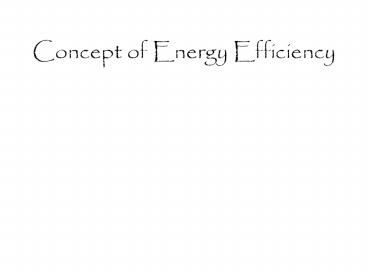Concept of Energy Efficiency - PowerPoint PPT Presentation
Title:
Concept of Energy Efficiency
Description:
Concept of Energy Efficiency Buildings, as they are designed and used, contribute to serious environmental problems because of excessive consumption of energy & other ... – PowerPoint PPT presentation
Number of Views:85
Avg rating:3.0/5.0
Title: Concept of Energy Efficiency
1
Concept of Energy Efficiency
2
Buildings, as they are designed and used,
contribute to serious environmental problems
because of excessive consumption of energy
other natural resources. The global energy
scenario has undergone a drastic change in the
last two decades. It is estimated that almost
2/3rd of the global energy demand is due to
buildings, as their construction, operation and
maintenance are concerned and is expected to grow
by an additional 45 percent by 2025. The
present day buildings that are designed and used,
symbolize un-restrained consumption of energy, be
it a five start hotel, commercial establishment,
govt buildings or a residence complex.
3
Commercial and residential buildings account for
more than 30 percent of the electricity
consumption in India. We add more than 40 million
sq. m of commercial and residential space
annually and this results in the additional
burden of 5.6 billion units of electricity. In
this scenario introduction of energy efficient
building design concept has become critical for
achieving the collective objectives of energy
security and environmental protection, which in
turn can ensure economic and social development.
4
- Energy resource efficiency in new constructions
can be effected by adopting an integrated
approach to building design. - The primary steps in this approach would be to
- Incorporate solar passive techniques in building
design to minimize load on conventional systems
(heating, cooling, ventilation and lighting). - Design energy efficient lighting and HVAC
systems. - Use renewable energy sources to meet part of
building load. - Use low energy materials methods of
construction reduce transportation energy. - Thus in brief, an energy efficient building
balances all aspects of energy use in a building
lighting, space-conditioning and ventilation, by
providing an optimised mix of passive solar
design strategies, energy-efficient equipments
and renewable sources of energy.
5
- The task of an Architect
- Architects can achieve energy efficiency in the
buildings they design by studying the macro-and
micro-climate of the site, applying bioclimatic
architectural principles. Some common design
elements that affect the thermal conditions are - Orientation The placement of the building in
north-south direction, reduces the heat energy
input in the building, increases overall
ventilation and provide thermal comfort to the
building . - Landscaping Landscaping alters the microclimate
of the site. It reduces direct sun from strikng
the building heating up the building surfaces. - Materials of construction Choice of building
materials is very important in reducing the
energy contents of buildings.
6
4. Location of water bodies Water is a very
good modifier of microclimate. It takes up large
amount of heat in evaporation and causes
significant cooling in hot and dry climate. On
the other hand,in humid climates, water should be
avoided as it adds to humidity. 5. Building
form/surface to volume ratio The volume of
space inside a building that needs to be heated
or cooled and its relationship with the area of
the envelope enclosing the volume affects the
thermal performance of the building. For any
given building volume, the more compact the
shape, the less wasteful it is in gaining/ losing
heat. Also, the building form determines the
airflow pattern a round the building, directly
affecting its ventilation.
7
- Some key energy saving measures
- Orient the building to have maximum exposure
maximum glazing along north and south facades. - Restrict the glazing area to a maximum of 40-50
of the gross external wall area. - Use atrium/skylights with adequate solar control
to provide daylight access into deeper spaces. - Use shading strategies for the east, west and
south facades to minimize solar gain and reduce
glare. - Use rigid insulation such as extruded or
expanded polystyrene, mineral wool for wall and
roof. - Use energy efficient glass with spectrally
selective coating to take maximum daylight and
yet have effective solar control. - Energy efficient devices such as CFLs, T-5
fluorescent lamps, electronic chokes, can be used
to reduce consumption.
8
- High efficiency chilling systems along with
appropriate controls should be used. - Devices such as heat recovery units, economizer
controls, should be explored. - Passive conditioning strategies such as earth
embedded cooling systems, thermal storage systems
etc., can also be explored to reduce demand on
conventional air conditioning. - By the application of these techniques , the
energy consumption and demand would come down,
which is good for people, society, nation and our
world.































